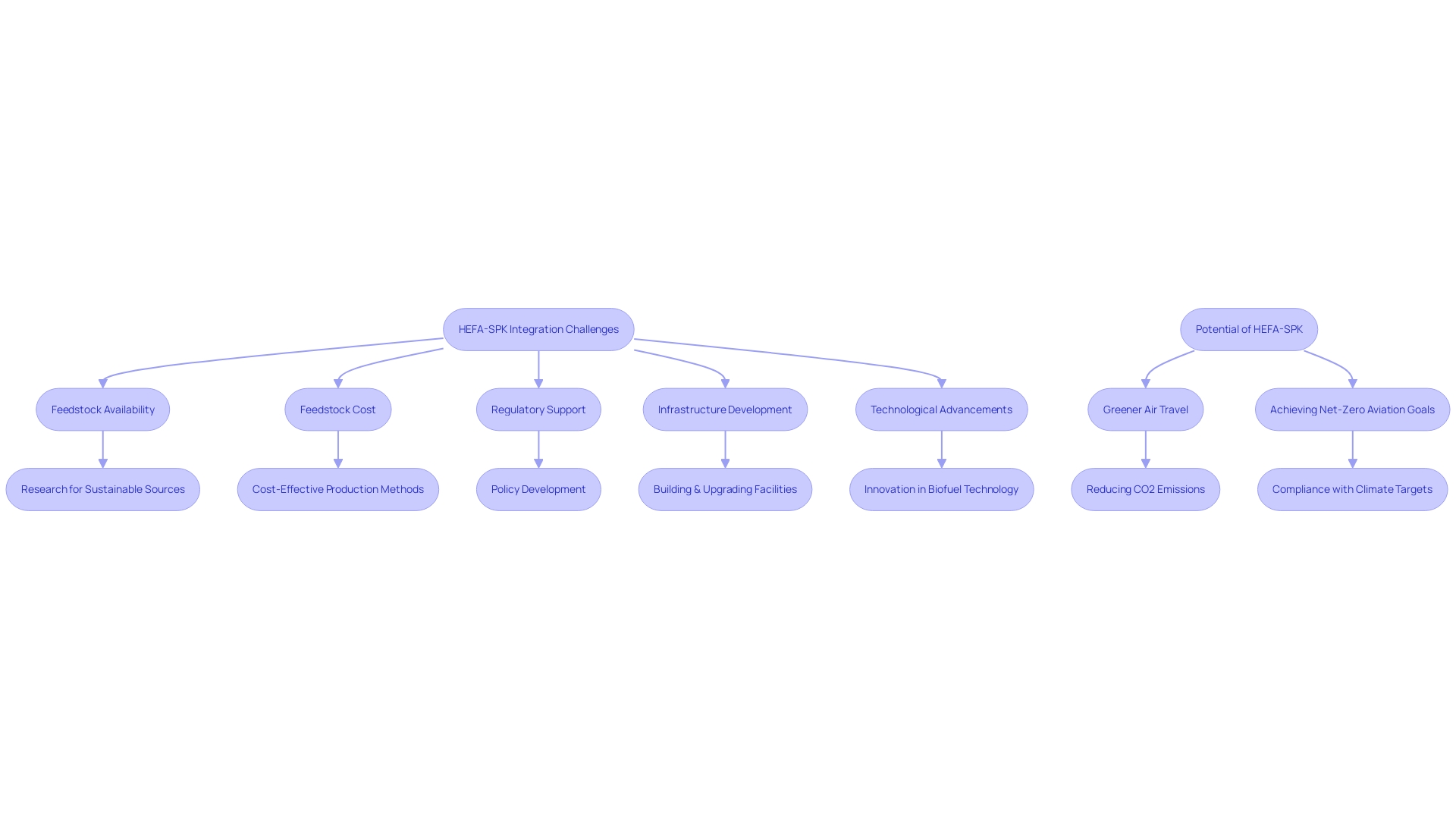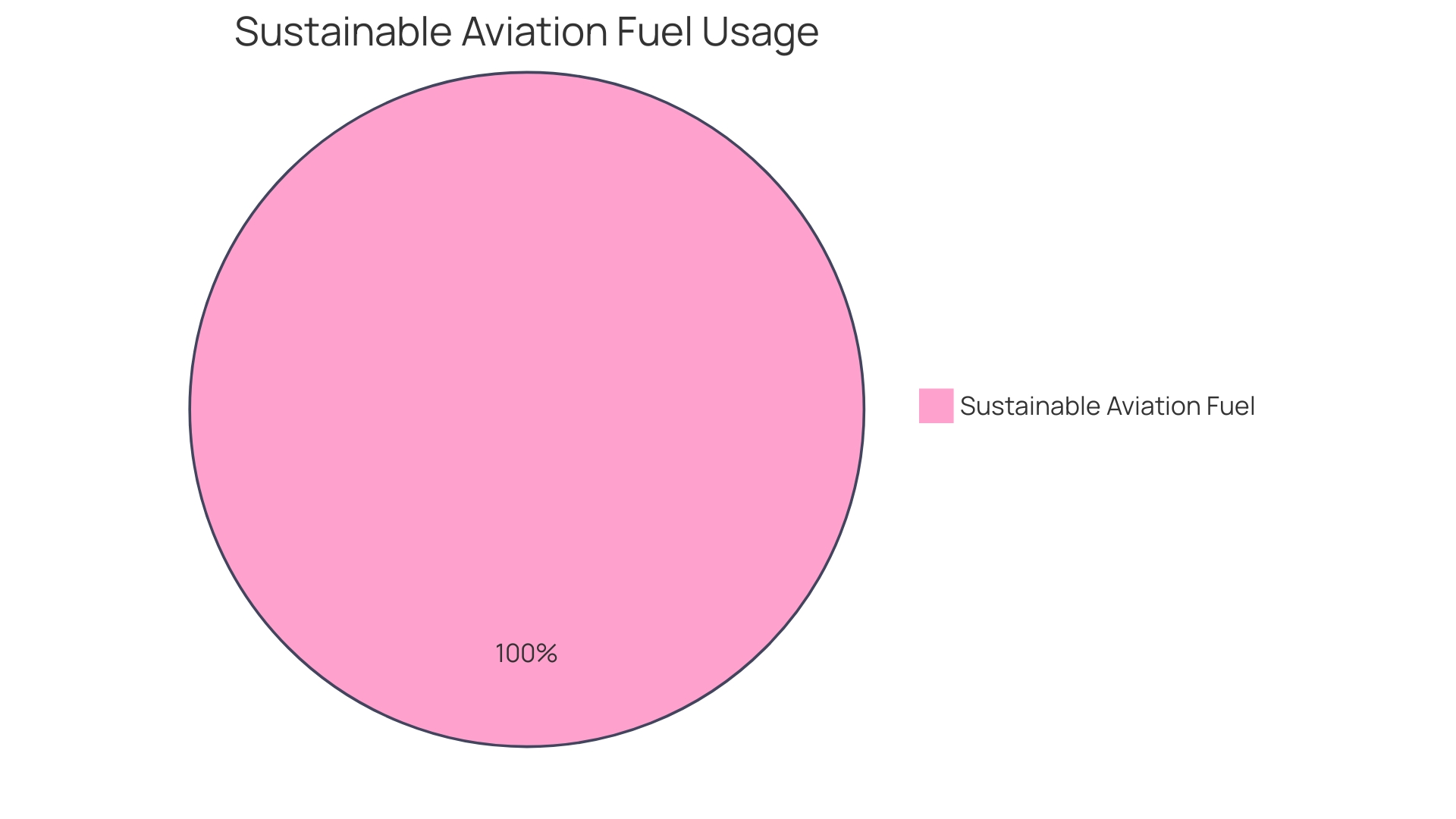Introduction
Hydroprocessed Esters and Fatty Acids-Synthetic Paraffinic Kerosene (HEFA-SPK) is revolutionizing the aviation industry as a sustainable aviation fuel (SAF). Crafted through the hydroprocessing of renewable resources like vegetable oils and animal fats, HEFA-SPK embodies the industry's commitment to reducing greenhouse gas emissions. With initiatives like Germany's eSAF project and Virgin Atlantic's strides towards net-zero carbon emissions, HEFA-SPK is poised to play a pivotal role in the global shift to climate-neutral aviation.
This article explores the significance of HEFA-SPK, the step-by-step process behind its production, its feedstocks, ASTM standards and certification, its benefits in emissions reduction, challenges and future prospects, comparisons with other SAF production pathways, infrastructure and regulatory frameworks, and real-world case studies. Join us on this journey towards a more sustainable and environmentally responsible aviation industry.
What is HEFA-SPK and Its Significance
Hydroprocessed Esters and Fatty Acids-Synthetic Paraffinic Kerosene, commonly known as HEFA-SPK, is making waves in the aviation sector as a sustainable aviation fuel (SAF). This eco-friendly alternative is crafted through the hydroprocessing of various renewable resources, including vegetable oils and animal fats. Its adoption is a testament to the industry's commitment to slashing greenhouse gas emissions and curbing the overall carbon footprint of aviation. With the broader movement towards decarbonization, exemplified by initiatives like Germany's eSAF project to produce sustainable fuels, HEFA-SPK is poised to play a pivotal role in the global shift to climate-neutral aviation.
The significance of HEFA-SPK is further underscored by recent milestones in aviation, such as Virgin Atlantic's strides towards net-zero carbon emissions. The integration of HEFA-SPK into the fuel mix aligns with the industry's safety culture and infrastructure while contributing to the reduction of delays and cancellations attributed to weather conditions. As airlines like Virgin Atlantic expand their networks and enhance customer service, the transition to HEFA-SPK and other SAFs becomes increasingly important in the journey towards a sustainable, competitive, and resilient aviation industry.
The HEFA Process: Step-by-Step Explanation
Transforming renewable feedstocks into sustainable aviation fuel (SAF), the Hydroprocessed Esters and Fatty Acids (HEFA) process plays a pivotal role in the aviation industry's move towards a greener future. The process begins with feedstock preparation where vegetable oils or animal fats are meticulously refined to eliminate impurities, ensuring that the subsequent stages are efficient and effective. The hydroprocessing stage is critical; under high pressure, hydrogen and a specific catalyst react with the feedstocks, converting them into hydrocarbons with properties similar to conventional jet fuel.
After hydroprocessing, the mixture undergoes separation and further refining to eradicate any residual impurities and to precisely tune the fuel properties to meet stringent specifications. The product, known as HEFA-SPK (Synthetic Paraffinic Kerosene), is then carefully blended with conventional jet fuel to ensure it achieves the necessary characteristics for safe aviation use. Only after passing rigorous testing to comply with ASTM standards and certification requirements, is the fuel deemed ready for distribution.
The final HEFA-SPK is a drop-in replacement for traditional jet fuel, seamlessly integrating into existing infrastructures and aircraft engines. This innovative advancement is evidenced by initiatives such as the groundbreaking transatlantic flight powered by alternative fuels, marking a significant step towards the aviation industry's net-zero carbon emissions goal. Moreover, the collaboration between Fertiberia and Heineken Spain exemplifies the broader commitment to sustainability, as they pioneer the use of green hydrogen to reduce emissions in the cultivation of malting barley, aligning with Heineken's ambition to brew using 100% renewable energy by 2025.
While SAF is currently powering only a fraction of flights, its potential is monumental, with initiatives like the Airbus and Neste partnership aiming to decarbonize aviation. The industry is poised for transformation, driven by innovation and a commitment to sustainability, and the HEFA process is at the heart of this progress, offering a cleaner, renewable fuel option for an industry committed to reducing its environmental footprint.

Feedstocks for HEFA-SPK Production
The process of creating Hydroprocessed Esters and Fatty Acids Synthetic Paraffinic Kerosene (HEFA-SPK) involves a selection of feedstocks that influence the sustainability and efficiency of production. While traditional feedstocks such as soybean, palm, and canola oils are prevalent due to their high energy content and established supply chains, emerging raw materials offer innovative prospects for the biofuel industry.
One such material is softwood bark, an abundant by-product in the Nordic forest industry, traditionally used as a low-value energy source. Research indicates that softwood bark is a veritable source of renewable chemicals like tannins, which constitute around 10% of the bark's makeup. These organic compounds are not only utilized in leather tanning but are also being explored for their potential in biobased chemical applications, including replacing phenols in thermosetting resins and serving as flocculants for water purification.
Furthermore, the process advancements in extracting tannins from softwood bark, such as hot water extraction, while currently resulting in low yields, signify a move towards utilizing co-streams effectively. The challenge lies in the high carbohydrate content, which limits the extract's applicability. However, with continued research and technological development, such as enzymatic treatments and nanofiltration, there is potential for creating refined tannin fractions that could revolutionize the HEFA-SPK production landscape.
In addition to plant-based sources, animal fats like tallow and yellow grease and recycled cooking oils provide alternative feedstocks that could contribute to a more circular economy. These options not only mitigate competition with food production but also align with global efforts to reduce reliance on fossil fuels and decrease CO2 emissions.
Innovations in the biofuel sector, such as the creation of pure lignin streams from non-food woody biomass, emphasize the industry's shift towards greener chemicals and sustainable practices. Moreover, the strategic utilization of renewable resources and the sequestration of carbon during the production of HEFA-SPK are pivotal in addressing the climate crisis and fostering a more environmentally responsible fuel industry.
ASTM Standards and Certification for HEFA-SPK
HEFA-SPK (Hydroprocessed Esters and Fatty Acids - Synthetic Paraffinic Kerosene) fuels are a vital component in the aviation industry's move towards more sustainable practices. The ASTM D7566 standard outlines the production and utilization of HEFA-SPK, ensuring it meets stringent quality benchmarks for use in aircraft. ASTM standards are not mere suggestions but are critical to ensuring uniformity and reliability in aviation operations, as they are developed through a consensus process that values transparency, stakeholder involvement, and due process.
By adhering to the ASTM D7566, producers and distributors of HEFA-SPK can guarantee their biofuel's properties, such as energy content and chemical composition, align with the high-performance requirements of modern aviation. This standardization is akin to the global consistency in product quality, regardless of the manufacturing location, ensuring that customers receive a dependable product that meets uniform specifications.
The importance of such standards can be seen in the broader context of industrial certification and regulation. For instance, the Air-Conditioning, Heating, and Refrigeration Institute (AHRI) certifies HVAC equipment against recognized standards to ensure efficiency and innovation in the industry. Similarly, for medical devices, the FDA's 510(K) premarket submission demonstrates that a new device is as safe and effective as an existing, legally marketed device.
The integration of HEFA-SPK into the aviation fuel supply chain, therefore, is not just about meeting fuel specifications; it is about maintaining the safety, quality, and efficiency standards that stakeholders, including manufacturers, airlines, and passengers, have come to expect. This is especially crucial in an era where aviation safety and performance are paramount, and the industry is under scrutiny to reduce its environmental footprint while maintaining operational excellence.
Benefits and Emissions Reductions of HEFA-SPK
Hydroprocessed Esters and Fatty Acids Synthetic Paraffinic Kerosene (HEFA-SPK) stands out as a transformative solution in the aviation industry's pursuit of sustainability. It's a renewable aviation fuel that promises up to 80% reduction in greenhouse gas emissions when compared to traditional jet fuel, owing to its innovative production from renewable feedstocks and advanced hydroprocessing technology.
Moreover, its attributes extend beyond carbon footprint reduction. HEFA-SPK contributes to improved local air quality by emitting lower levels of sulfur compounds and particulate matter, which is particularly beneficial in the vicinity of airports. Importantly, HEFA-SPK's 'drop-in' feature allows it to be seamlessly integrated into the existing fuel infrastructure and used in aircraft engines without any modifications, simplifying the transition to more sustainable fuel options for airlines.
Virgin Atlantic's recent advancements illustrate the industry's commitment to reducing its environmental impact. Notably, the airline's expanding network, including new routes to the US, underlines the potential for sustainable fuels like HEFA-SPK to play a crucial role in global aviation's path to net-zero carbon emissions. In collaboration with partners such as Delta Air Lines and Air France-KLM, Virgin Atlantic demonstrates a joint venture's power to foster a greener, more efficient aviation sector.
The emerging strategic partnerships and innovations in the industry, including the UK Hydrogen in Aviation alliance spearheaded by companies like easyJet and Rolls-Royce, signal a broader shift towards cleaner, renewable energy sources. These initiatives, alongside the successful tests of hydrogen-powered engines, indicate a future where HEFA-SPK and similar sustainable fuels are integral to achieving aviation's environmental goals.
As the aviation industry continues to navigate the challenges of climate change, the adoption of HEFA-SPK is a clear indicator of its dedication to sustainability. This commitment is echoed in the sentiments of industry experts and enthusiasts, who recognize the importance of safety, efficiency, and environmental stewardship in commercial aviation.
Challenges and Future Prospects for HEFA-SPK
The evolution of HEFA-SPK (Hydroprocessed Esters and Fatty Acids Synthetic Paraffinic Kerosene) is critical in advancing sustainable aviation fuel (SAF), yet its broader integration faces several challenges:
-
Feedstock Availability and Cost: The sustainability of HEFA-SPK hinges on a consistent supply of feedstocks such as waste cooking oil, energy crops, and other biomass resources. This must be balanced with environmental considerations to avoid negative impacts like deforestation and competition with food production.
-
Regulatory Support: For HEFA-SPK to truly flourish, it must be bolstered by ongoing regulatory frameworks and incentives that encourage investment and foster an economically viable market for SAF.
-
Infrastructure Development: The expansion of facilities for producing, distributing, and storing HEFA-SPK is essential. This entails developing technologies akin to KRISO's offshore hydrogen and ammonia production platform, which utilizes green hydrogen from renewable sources.
-
Technological Advancements: Enhancing the efficiency of the HEFA process is vital. This includes exploring power-to-liquid methods, where renewable electricity, water, and captured CO2 are transformed into liquid fuels, addressing the need for large volumes required by long-haul flights.
Despite these hurdles, the potential for HEFA-SPK to significantly contribute to greener air travel is considerable, particularly as the aviation industry moves towards its net-zero goals, supported by organizations like the International Air Transport Association. With advancements in technology and infrastructure, bolstered by regulatory support, the promise of HEFA-SPK in the sustainable energy landscape shines bright, echoing sentiments from industry leaders that herald hydrogen as the 'golden molecule' for sustainable energy.

Comparing HEFA-SPK with Other SAF Production Pathways
Exploring the landscape of sustainable aviation fuel (SAF) production, we find several pathways, each with unique attributes and developmental stages. The HEFA-SPK (Hydroprocessed Esters and Fatty Acids Synthetic Paraffinic Kerosene) pathway is prominent for its ability to produce jet fuel from renewable lipids like vegetable oils and animal fats. Compared to conventional jet fuel, HEFA-SPK can reduce greenhouse gas emissions significantly, making it an attractive option for airlines aiming to lower their carbon footprint.
Alcohol-to-Jet (ATJ) involves transforming alcohols such as ethanol into jet fuel. This pathway is adaptable to various feedstocks, including those derived from biomass. However, its complexity and the need for additional processing might drive up production costs.
The Fischer-Tropsch (FT) process converts carbon-rich materials into synthetic hydrocarbons. While FT fuels are compatible with current jet engines, the process requires substantial capital investment and can be associated with higher carbon emissions, especially if fossil resources are used as feedstocks.
Power-to-Liquid (PtL) synthesizes fuels from renewable electricity, water, and carbon dioxide. PtL fuels have the potential to be carbon-neutral, yet the technology is in its infancy, challenged by issues of scale and economics.
In the broader context of aviation's environmental impact, it's important to recognize that commercial aviation contributes approximately 3.5% to human-induced climate change. With CO2 emissions from aviation having doubled since the mid-1980s, the industry is under pressure to find sustainable alternatives.
Recent developments, such as the pioneering transatlantic flight powered solely by alternative fuels, underscore the viability of SAF. Although this Virgin Atlantic flight served as a proof of concept, regular use of SAF is hindered by limited supply and the need for substantial production volumes for long-haul flights.
As we venture into this new era of aviation, it's crucial to continue educating the public about SAF. Misconceptions persist, but with increased awareness and strategic partnerships, the industry can progress towards its net-zero ambitions. Scaling up SAF production is imperative, as is innovation in this sector, to meet the surging global demand for environmentally friendly air travel options.

Infrastructure and Regulatory Framework for HEFA-SPK
To meet the rising demand for sustainable aviation fuel, particularly HEFA-SPK (Hydroprocessed Esters and Fatty Acids Synthetic Paraffinic Kerosene), the aviation industry must construct a comprehensive infrastructure allied with a supportive regulatory landscape.
-
Production Facilities: For the production of HEFA-SPK to scale up effectively, the development of production sites is paramount. These should be optimally located, taking into account the accessibility of feedstock, the logistics of transportation, and the proximity to airports, ensuring operational efficiency. Entities like the HAECO Group have set precedent in delivering high-quality aviation services while emphasizing safety, quality, and sustainability.
-
Distribution Networks: Enhancing HEFA-SPK's distribution networks is essential to guarantee its consistent availability across global airports. This expansion is a critical step towards securing a steady supply chain that can support widespread utilization of HEFA-SPK in the aviation sector.
-
Collaborative Partnerships: The integration of HEFA-SPK into the mainstream aviation fuel mix necessitates robust partnerships among airlines, fuel suppliers, and governmental organizations. This collective effort is crucial for steering investments, exchanging industry best practices, and framing uniform standards and certifications, much like the collaborative ethos underscored by the FTE APEX Asia Expo.
-
Regulatory Support: The role of governments and regulatory bodies is critical in facilitating a market conducive to HEFA-SPK adoption. Their support could manifest through incentives, sustainable aviation fuel targets, and the formulation of explicit regulations and standards. Such support aligns with insights from aviation and energy stakeholders, who advocate for a concerted effort and clear policy directions to scale sustainable aviation fuels (SAFs).
In pursuing these strategies, the aviation industry can expedite the adoption of HEFA-SPK, thus contributing significantly to the sustainability of future air travel while navigating the challenges of the global aerospace supply chain and energy resource management.

Case Studies and Commercial Applications of HEFA-SPK
The integration of HEFA-SPK (Hydroprocessed Esters and Fatty Acids Synthetic Paraffinic Kerosene) into commercial aviation is a testament to the industry's commitment to environmental sustainability. Through a collaborative effort among stakeholders in the aviation and energy industries, as well as the public sector, significant strides have been made in scaling up the use of Sustainable Aviation Fuel (SAF).
At the heart of this movement are the economic and environmental imperatives driving the adoption of cleaner fuels. The aviation sector is keenly aware of its role in contributing to global CO2 emissions, which are a major factor in climate change. In response, the industry has been exploring various strategies and policy efforts to reduce its carbon footprint. As environmental impacts from aviation, such as CO2 emissions and nitrogen oxides, become increasingly concerning, the shift toward SAF, including HEFA-SPK, offers a tangible solution for reducing the industry's environmental impact.
The viability of HEFA-SPK is further underscored by the success stories from various regions, including Europe, the US, and the Middle East. These regions have provided actionable insights and recommendations for fostering a collaborative environment conducive to the expansion of SAF. This global perspective on the benefits of HEFA-SPK is reinforced by the latest developments in energy and standardization, such as the advancements in hydrogen refuelling protocols and the call for a systematic approach to standards development.
This collective effort is ultimately aimed at achieving a more sustainable aviation industry, one that not only meets the needs of today's global travel but also safeguards the environment for future generations. The transition to HEFA-SPK and other forms of SAF is not just an environmental necessity; it also represents an opportunity for the aviation industry to lead by example in the global fight against climate change.
Conclusion
HEFA-SPK, a sustainable aviation fuel (SAF) crafted from renewable resources like vegetable oils and animal fats, is revolutionizing the aviation industry. Its production process, the HEFA process, ensures a drop-in replacement for traditional jet fuel. HEFA-SPK's adherence to ASTM standards and certification guarantees uniformity and reliability in aviation operations.
The benefits of HEFA-SPK extend beyond carbon footprint reduction, including improved local air quality and seamless integration into existing fuel infrastructure. Despite challenges such as feedstock availability and regulatory support, HEFA-SPK shows significant potential in contributing to greener air travel.
Comparing HEFA-SPK with other sustainable aviation fuel production pathways highlights its unique attributes and potential for greenhouse gas emissions reduction. To fully integrate HEFA-SPK into the aviation sector, a comprehensive infrastructure and supportive regulatory framework are necessary.
The successful commercial applications of HEFA-SPK underscore the industry's commitment to environmental sustainability. The transition to HEFA-SPK and other forms of SAF represents an opportunity for the aviation industry to lead in the global fight against climate change.




